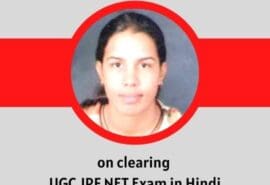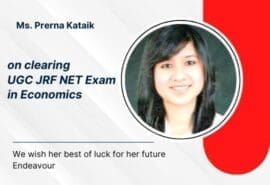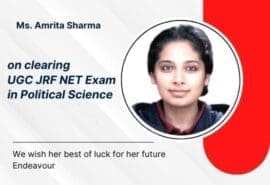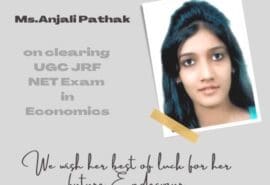
Top 20 Major Points about UGC JRF Net Economics
Top 20 Major Points about UGC JRF Net Economics
Here are the top 20 major points about UGC JRF Net Economics:
- NTA conducts the exam to determine eligibility for JRF and Assistant Professor Positions in Indian universities and colleges.
- It is held twice a year - June and December. Exam pattern is subjective (theoretical/analytical/numerical).
- The syllabus is divided into two papers - Paper I on Teaching and Research Methodology and Paper II on Economics subjects.
- Core focus areas are microeconomics, macroeconomics, public economics, international economics, statistics, econometrics, etc.
- Revision of basic economic principles, concepts and theories from the bachelor's curriculum is very important.
- Equal weightage is given to theory and quantitative techniques like mathematical economics, models, and applications.
- Previous years' question papers provide insights on the latest trends in paper setting, crucial topics, etc.
- UGC provides detailed exam notifications regarding eligibility, syllabus, paper scheme, exam cities, etc.
- Registration timeline - usually one month from notification release. Admit cards are available three weeks before the exam.
- Results are declared in 6 months—separate cutoffs and merit lists for General and reserved categories.
- The JRF fellowship tenure is two years—the opportunity to pursue PhD at a recognized university.
- Being a highly competitive exam, having conceptual clarity on each topic is vital for success.
- Guidance from coaching institutes and mentors helps improve understanding of concepts and exam preparedness.
- Appearing for several mock tests helps assess strong and weak areas.
- A planned revision strategy focused on clearing core concepts is crucial.
- Proper time management in the exam to maximize attempts with accuracy is key.
- Marking scheme - Paper 1: 100 marks (50 MCQs + 5 descriptive questions); Paper II: 100 marks (2 theoretical + 1 case study based analytical question)
- UGC conducts fresh placement of JRFs based on the number of available vacancies each year.
- Opens up teaching and research opportunities in Economics across government and private universities.
- With thorough practice and analysis-driven review methods, one can aim to excel in the UGC JRF Economics exam.
Thanks for visiting our website Mantram Study Group.
Visit us for Economics Coaching in Chandigarh
CHECK OUR OTHER LINKS: -
- UGC JRF NET Economics Exam Preparation Coaching
- UGC JRF NET Sociology Exam Preparation Coaching
- UGC NET Paper I Exam Coaching In Chandigarh
- Best Coaching Institute for Ugc Net Management
- Best UGC NET Commerce Coaching in India
- Sainik School Entrance Coaching
- BSc Agriculture Entrance Coaching Classes
Testimonials
Why Join Mantram UGC JRF Net Economics?
![]() Mantram prioritizes staying abreast of the latest exam formats and syllabus revisions. It regularly refreshes its educational materials and resources, guaranteeing that students can access the most up-to-date study tools and information, keeping them at the forefront of exam preparedness.
Mantram prioritizes staying abreast of the latest exam formats and syllabus revisions. It regularly refreshes its educational materials and resources, guaranteeing that students can access the most up-to-date study tools and information, keeping them at the forefront of exam preparedness.
![]() By integrating meticulously scheduled mock exams into its curriculum, the Mantram Study Group seeks to fully equip students for the NTA UGC JRF NET Economics test. These evaluations are critical for developing endurance and acquainting students with the exam's layout. Insights from these tests highlight areas needing attention, offering actionable advice for efficiently navigating exam segments and enhancing study routines.
By integrating meticulously scheduled mock exams into its curriculum, the Mantram Study Group seeks to fully equip students for the NTA UGC JRF NET Economics test. These evaluations are critical for developing endurance and acquainting students with the exam's layout. Insights from these tests highlight areas needing attention, offering actionable advice for efficiently navigating exam segments and enhancing study routines.
![]() The Mantram Study Group integrates planned mock examinations into its curriculum to efficiently prime students for the NTA UGC JRF NET Economics exam. These tests are essential for developing a detailed familiarity with the exam format and enhancing stamina. Feedback from these exams highlights improvement areas, providing specific recommendations for tackling exam sections and optimizing study routines.
The Mantram Study Group integrates planned mock examinations into its curriculum to efficiently prime students for the NTA UGC JRF NET Economics exam. These tests are essential for developing a detailed familiarity with the exam format and enhancing stamina. Feedback from these exams highlights improvement areas, providing specific recommendations for tackling exam sections and optimizing study routines.
![]() Staying updated with the latest trends in examination patterns and syllabus changes is a top priority for Mantram. The Institute continually revises its learning materials, ensuring students can access the latest educational resources and insights, enhancing their exam readiness.
Staying updated with the latest trends in examination patterns and syllabus changes is a top priority for Mantram. The Institute continually revises its learning materials, ensuring students can access the latest educational resources and insights, enhancing their exam readiness.
FAQ
Q. What is the typical salary range for a government economist in India?
In India, the salary for an economist in government positions ranges from ₹2.5 lakhs to ₹38.0 lakhs per year, with an average wage of approximately ₹16.4 lakhs, depending on experience and seniority.
Q. Which is the most challenging subject in UGC NET?
The difficulty level of subjects in UGC NET can vary depending on individual strengths and interests. However, all topics should be considered possible in UGC NET economics if aspirants receive the proper guidance and coaching. Fortunately, Mantram excels in providing top-notch coaching, boasting a panel of experienced faculty members with over 15 years of expertise.
With their support and guidance, aspiring candidates can navigate the subjects effectively and increase their chances of smoothly cracking the exam. The key to success lies in dedication, perseverance, and the support of a reputable coaching institute like Mantram.













































